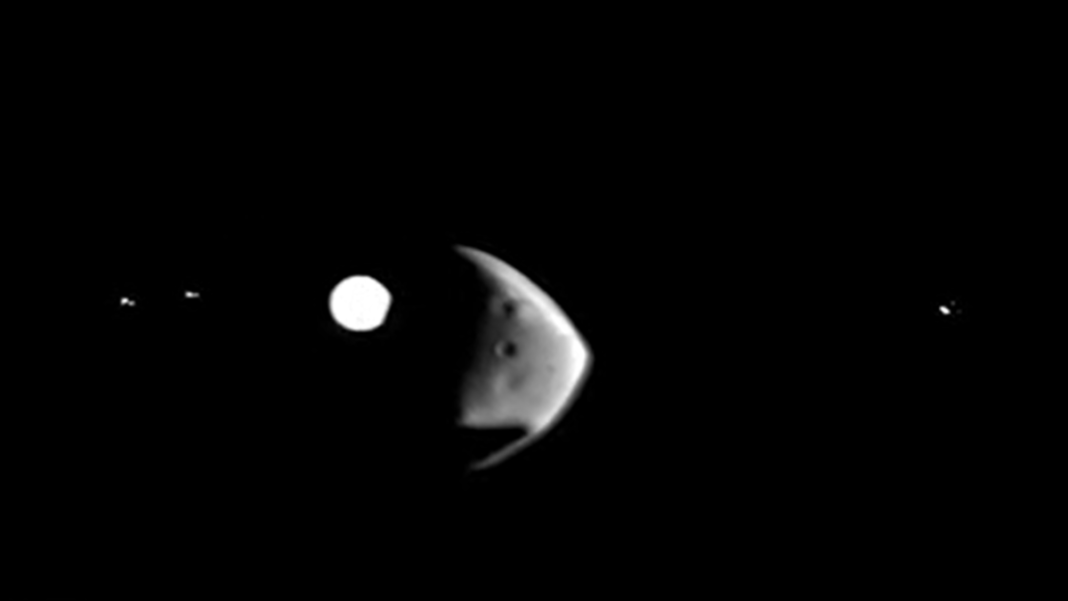Now you see it, now you don’t.
The Mars Express spacecraft has witnessed a rare spectacle, spotting Mars‘ moon Deimos appearing to pass in front of Jupiter and its moons on Valentine’s Day (Feb. 14). The event, called an occultation, allows scientists to compute Deimos’ orbit around the Red Planet even more accurately, a surprisingly difficult task.
In astronomy, an occultation occurs when one celestial object moves in front of another, blocking the more distant object from view. In the newly released video, which comprises 80 frames taken by the Mars Express spacecraft’s High Resolution Stereo Camera, Deimos first moves in front of the points of light that are the ocean moons Europa and Ganymede. It then crosses in front of the white disk of Jupiter, and then finally the other two large Jovian moons, volcanic Io and icy Callisto.
Related: Moons of Mars: Amazing photos of Phobos and Deimos
At the time, the Jupiter system was about 463 million miles (745 million kilometers) from Deimos, which is about 7.7 miles (12.4 km) wide.
A few weeks later, on March 30, Mars’ second moon, Phobos, passed in front of Deimos as seen by Mars Express.
For scientists studying Mars’ moons, all of these occultation events are important for nailing down the orbits of Deimos and Phobos more precisely. It’s perhaps surprising that astronomers don’t know the precise shape and size of Phobos and Deimos’ orbits. But scientists do know that gravitational forces between the moons and Mars are causing the orbits of the moons to change.
Phobos, which is 14 miles (22.5 km) wide, orbits just 3,721 miles (5,989 kilometers) above the Red Planet — close enough that it moves around Mars faster than Mars rotates. The super-speedy orbit makes the tidal bulge in Mars caused by Phobos’ gravity lag behind the moon. The bulge’s gravity then pulls back at Phobos, causing Phobos to gradually decelerate and slowly inch closer to Mars. Within 50 million years, Phobos will be so close to Mars and the tidal forces so powerful that Phobos will break apart, the debris either raining down on Mars or forming a ring.
Deimos, on the other hand, has a wider orbit of 14,580 miles (23,460 km), resulting in its orbital period being slower than Mars’ rotation. This means that the tidal bulge in Mars created by Deimos’ gravity gets carried ahead of Deimos, causing the moon’s orbital speed to accelerate as the bulge’s gravity pulls on Deimos. Consequently, its orbit grows wider over time. Earth’s moon is slowly moving away from our planet due to the same type of interaction.
Although scientists understand the factors changing Phobos’ and Deimos’ orbits, efforts to precisely measure the orbits of the two moons have encountered difficulties. The moons are often lost in Mars’ glare when viewed from Earth, so we have to rely on spacecraft at the Red Planet to make measurements. One way to do so is to time the duration of occultations. The amount of time that it took for Deimos to obscure Jupiter tells scientists exactly how far from Mars the moon is.
The European Space Agency’s Mars Express mission has been watching occultations of solar system bodies by Mars’ moons for the past 14 years, using these events to constrain the orbits of Phobos and Deimos, improving our orbital measurements by 1.6 to 2 miles (1 to 2 km).
The occultation views also show how misshapen both moons are; one theory is that they were captured from the nearby asteroid belt, while another is they are fragments of a larger moon that was shattered by an impact 2.7 billion years ago.
Follow Keith Cooper on Twitter @21stCenturySETI. Follow us on Twitter @Spacedotcom and on Facebook.


